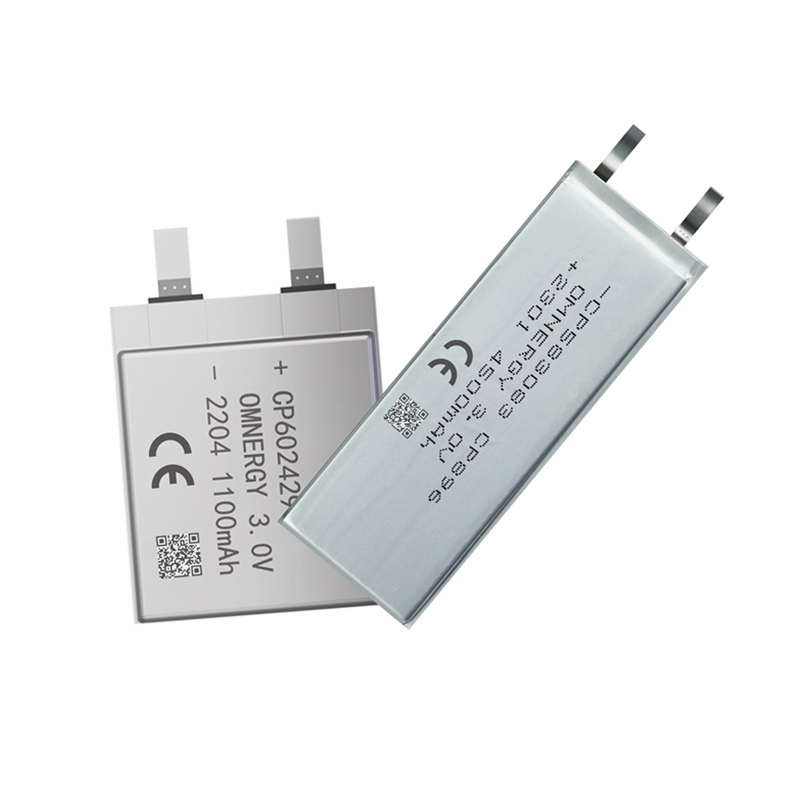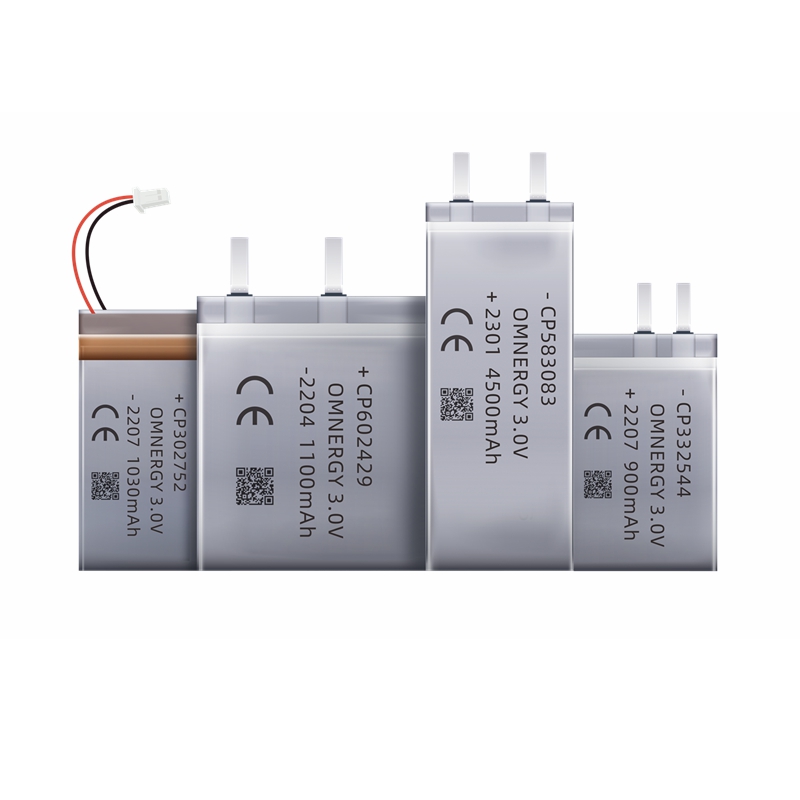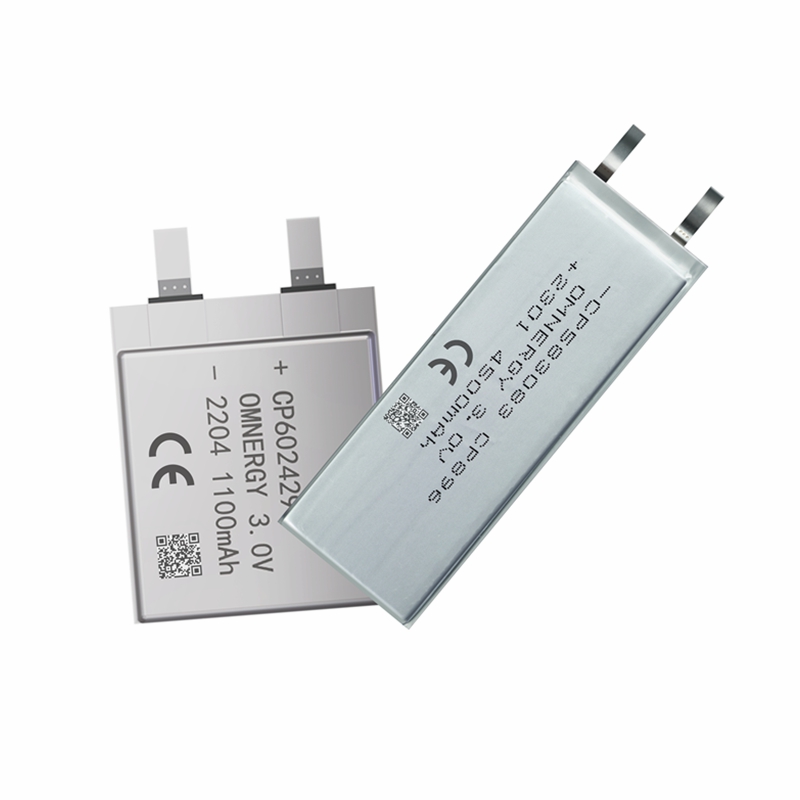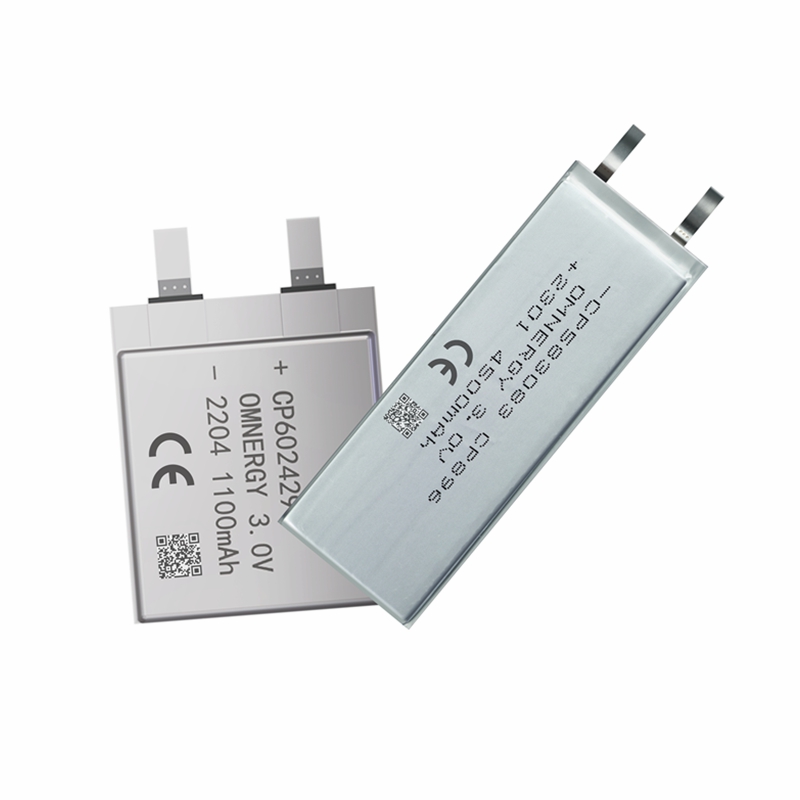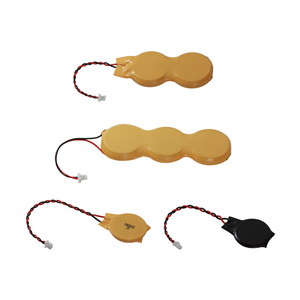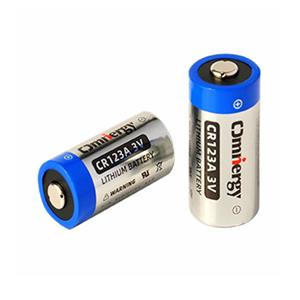CP405050 Lithium Manganese Soft-Pack Battery

- Omnergy
- China
- 15 days
- 750 million per year
Against the backdrop of the growing demand for miniaturization and long life of IoT devices and smart terminals, lithium manganese soft-pack batteries have become an ideal choice for high energy density energy supply solutions with their unique physical and electrochemical properties. As an important member of the primary battery (non-rechargeable) family, CP405050 breaks through the limitations of traditional metal shells with its soft-pack structure, integrating the high-voltage platform of the lithium manganese chemical system with the ultra-thin form of the soft-pack design, providing space-sensitive electronic devices with both lightweight and highly reliable energy solutions.
CP405050 Lithium Manganese Soft-Pack Battery
Model | Nominal Voltage (V) | Nominal Capacity (mAh) | Standard Current (mA) | Max Continuous Current (mA) | Max Pulse Current (mA) | Max Dimensions (mm) | The Electrode Structure | Weight Approx (g) |
| CP114752 | 3.0 | 520mAh | 1mA | 50mA | 100mA | 1.15*47*52 | Laminating Structure | 4.8 |
| CP223830 | 3.0 | 400mAh | 2mA | 100mA | 200mA | 2.2*39*30 | Winding Structure | 3.6 |
| CP224147 | 3.0 | 900mAh | 5mA | 200mA | 400mA | 2.2*45*48 | Winding Structure | 7.5 |
| CP224642 | 3.0 | 920mAh | 2mA | 50mA | 150mA | 2.2*46*42 | Laminating Structure | 7.5 |
| CP255083 | 3.0 | 2400mAh | 5mA | 800mA | 1500mA | 2.5*50*83 | Winding Structure | 18.0 |
| CP262030 | 3.0 | 260mAh | 1mA | 16.5mA | 50mA | 2.6*20*30 | Laminating Structure | 2.5 |
| CP301330 | 3.0 | 180mAh | 1mA | 50mA | 100mA | 3.0*13*30 | Winding Structure | 1.8 |
| CP302525 | 3.0 | 400mAh | 1mA | 16.5mA | 50mA | 3.0*25*25 | Laminating Structure | 3.5 |
| CP302752 | 3.0 | 1030mAh | 2mA | 66mA | 100mA | 3.0*27*52 | Laminating Structure | 7.5 |
| CP302775 | 3.0 | 1450mAh | 5mA | 300mA | 500mA | 3.0*27*75 | Winding Structure | 10.5 |
| CP305050 | 3.0 | 2000mAh | 3mA | 66mA | 200mA | 3.0*50*51 | Laminating Structure | 14.0 |
| CP332544 | 3.0 | 750mAh | 5mA | 150mA | 300mA | 3.3*25.5*44 | Winding Structure | 6.0 |
| CP332544 | 3.0 | 900mAh | 1mA | 50mA | 90mA | 3.3*25.5*44 | Laminating Structure | 7.0 |
| CP352865 | 3.0 | 1500mAh | 5mA | 400mA | 800mA | 3.5*28*65 | Winding Structure | 11.0 |
| CP383047 | 3.0 | 1300mAh | 5mA | 400mA | 800mA | 3.9*30*47 | Winding Structure | 9.5 |
| CP403555 | 3.0 | 1600mAh | 5mA | 400mA | 800mA | 4.0*35*55 | Winding Structure | 12.0 |
| CP405050 | 3.0 | 2500mAh | 10mA | 800mA | 1500mA | 4.0*50*51 | Winding Structure | 18.5 |
| CP405060 | 3.0 | 3200mAh | 10mA | 1000mA | 2000mA | 4.0*50*60 | Winding Structure | 24.0 |
| CP502030 | 3.0 | 900mAh | 1mA | 16.5mA | 50mA | 5.0*20*30 | Laminating Structure | 7.0 |
| CP502525 | 3.0 | 600mAh | 2mA | 100mA | 200mA | 5.0*25*25 | Winding Structure | 4.8 |
| CP502440 | 3.0 | 1200mAh | 5mA | 300mA | 500mA | 5.2*24*41 | Winding Structure | 9.0 |
| CP502495 | 3.0 | 3500mAh | 3mA | 100mA | 300mA | 5.0*24*95 | Laminating Structure | 23.0 |
| CP5024110 | 3.0 | 4000mAh | 5mA | 120mA | 350mA | 5.0*24*110 | Laminating Structure | 29.0 |
| CP505050 | 3.0 | 3300mAh | 10mA | 1000mA | 2000mA | 5.0*50*51 | Winding Structure | 23.5 |
| CP505070 | 3.0 | 5000mAh | 10mA | 1500mA | 2500mA | 5.0*50*70 | Winding Structure | 34.5 |
| CP552723 | 3.0 | 850mAh | 1mA | 16.5mA | 50mA | 5.5*27*23 | Laminating Structure | 7.0 |
| CP583083 | 3.0 | 4000mAh | 10mA | 1000mA | 2000mA | 5.8*30*83 | Winding Structure | 27.0 |
| CP583083 | 3.0 | 4500mAh | 5mA | 120mA | 350mA | 5.8*30*83 | Laminating Structure | 27.0 |
| CP601967 | 3.0 | 1800mAh | 5mA | 300mA | 500mA | 6.0*19*65 | Winding Structure | 13.5 |
| CP602429 | 3.0 | 1100mAh | 2mA | 16.5mA | 50mA | 6.0*24*29 | Laminating Structure | 8.0 |
| CP602446 | 3.0 | 1600mAh | 5mA | 400mA | 800mA | 6.0*24*46 | Winding Structure | 12.0 |
| CP602446 | 3.0 | 1900mAh | 3mA | 66mA | 200mA | 6.0*24*46 | Laminating Structure | 13.0 |
Against the backdrop of the growing demand for miniaturization and long life of IoT devices and smart terminals, lithium manganese soft-pack batteries have become an ideal choice for high energy density energy supply solutions with their unique physical and electrochemical properties. As an important member of the primary battery (non-rechargeable) family, CP405050 breaks through the limitations of traditional metal shells with its soft-pack structure, integrating the high-voltage platform of the lithium manganese chemical system with the ultra-thin form of the soft-pack design, providing space-sensitive electronic devices with both lightweight and highly reliable energy solutions.
1. Core features and technical advantages of the product
Ultra-thin and lightweight structural design
CP405050 is encapsulated in aluminum-plastic composite film, with dimensions of 4.0×50×50mm (typical value) and a weight of only 18.5g, which is more than 30% lighter than steel-shell batteries of the same capacity. It provides a flexible power adapter solution for micro devices such as electronic price tags and medical sensors.
High-performance electrochemical characteristics
Based on the lithium-manganese dioxide (Li-MnO₂) reaction system, it provides a 3.0V stable voltage platform and a smooth discharge curve (cut-off voltage 2.0V). The rated capacity is 2500mAh, supporting a maximum continuous current of 800mA and a pulse current output of 1500mA, meeting the sudden communication needs of smart devices.
Environmental adaptability and safety
Wide temperature range operation: stable discharge at -20℃~60℃, adapting to various high and low temperature complex environments.
High safety: The aluminum-plastic film structure reduces the risk of explosion, passes UL and IEC60086-4 safety certification, and has no heavy metal pollution.
Long-life storage: annual self-discharge rate ≤1%, long storage life at room temperature, ensuring that emergency equipment is available at any time.
Process innovation advantages
Adopting a laminated-winding composite structure, the internal resistance is reduced by connecting multiple poles in parallel, solving the pain point of poor high current performance of traditional winding batteries. The positive electrode slurry uses an oil system to improve the uniformity of the conductive network, and the energy density can reach 900Wh/L.
2. Detailed explanation of key performance parameters:
Nominal voltage: 3.0V
Termination voltage: 2.0V
Rated capacity: 2500mAh
Continuous current: 800mA
Pulse current: 1500mA
Operating temperature: -20℃~60℃
Storage temperature: -5℃~35℃
Annual self-discharge rate: ≤1%
Recommended humidity <70%RH
Dimensions: 4.0×50×50mm
Weight: 18.5g
3. Application scenario analysis
Internet of Things and smart terminals
Active RFID tags: Provide 10 years of maintenance-free power supply for smart parking lots and container tracking
Electronic price tags: Ultra-thin features are suitable for 2mm thick terminals and support real-time price refresh
Smart meters: Wireless communication modules for water/electricity/gas meters are powered and can withstand extreme outdoor temperatures.
High-end industrial and special equipment
Medical electronics: implantable devices, portable monitors
Safety systems: fire alarms, infrared surveillance cameras, using low self-discharge to ensure emergency start-up
Military and aviation: individual radio stations, drone payloads, adapting to -20℃ extreme cold environments.
Emerging technology fields
Deep-sea detectors: pressure-resistant packaging supports underwater robot power
Solar matching: integrated with photovoltaic modules, used for off-grid weather stations
Smart wearable devices: flexible design adapts to the curved space of bracelets/health monitors.
4. Customization and service support
CP405050 supports deep customized development and can be adjusted according to needs.
CP405050 lithium manganese soft pack batteries solve the contradiction between the installation space of micro-devices and the large current pulse requirements of traditional lithium batteries through material innovation and structural innovation. Its ultra-long storage life and -20℃ cold start capability are promoting technological breakthroughs in cutting-edge fields such as remote sensing equipment, military individual systems, and deep-sea detectors. As the number of IoT nodes approaches the hundreds of billions, this type of power solution that combines high energy density with flexible design will become a key enabling factor for smart hardware innovation.

